Blues
Reviews
April/May 2017
Slippery Noodle
Sound
What Exactly Does A Noodle Sound Like?
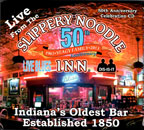 The
Slippery Noodle Inn, Indiana’s oldest continually operated bar,
has a rich history. Built in 1850 as a luxurious road house for the railway,
it was also a stop on the Underground Railroad. By the turn of the century
it hosted gangsters, a brothel, a brewery, a livery stable and slaughterhouse
- but after a hundred years it was just a neighborhood tavern. Harold
and Lorean Yeagy bought the bar in 1963, on Friday the 13th and after
a bout of late night drinks dubbed it The Slippery Noodle Inn. It’s
been in the family since. Their son, Hal Yeagy, took over running the
bar in 1985 after his father’s death and since that time it’s
grown from a one room lunch counter into the Midwest’s premiere
blues club, winning the Blues Foundation’s Keeping the Blues Alive
Award as Blues Club of the Year in 2003. Home of the Blues in Indiana
it features blues seven nights a week including local, regional and national
acts. With all this historical music being created, in 1993 Hal decided
to commemorate their 30th anniversary with the release of “Live
From the Slippery Noodle Volume 1,” a compilation album from some
of their best shows released on their own label, Slippery Noodle Sound.
More live compilation albums followed with Volume 2 in 1994, Volume 3
in 1997 and “Live From the Slippery Noodle Inn 50th Anniversary”
a live 3 CD set released in 2013.
The
Slippery Noodle Inn, Indiana’s oldest continually operated bar,
has a rich history. Built in 1850 as a luxurious road house for the railway,
it was also a stop on the Underground Railroad. By the turn of the century
it hosted gangsters, a brothel, a brewery, a livery stable and slaughterhouse
- but after a hundred years it was just a neighborhood tavern. Harold
and Lorean Yeagy bought the bar in 1963, on Friday the 13th and after
a bout of late night drinks dubbed it The Slippery Noodle Inn. It’s
been in the family since. Their son, Hal Yeagy, took over running the
bar in 1985 after his father’s death and since that time it’s
grown from a one room lunch counter into the Midwest’s premiere
blues club, winning the Blues Foundation’s Keeping the Blues Alive
Award as Blues Club of the Year in 2003. Home of the Blues in Indiana
it features blues seven nights a week including local, regional and national
acts. With all this historical music being created, in 1993 Hal decided
to commemorate their 30th anniversary with the release of “Live
From the Slippery Noodle Volume 1,” a compilation album from some
of their best shows released on their own label, Slippery Noodle Sound.
More live compilation albums followed with Volume 2 in 1994, Volume 3
in 1997 and “Live From the Slippery Noodle Inn 50th Anniversary”
a live 3 CD set released in 2013.
They’ve also produced a series of studio recordings including Yank
Rachell and David Morgan “Pig Trader Blues,” David Morgan’s
“I Never Knew She Was Married,” The Cooler Kings “Looks
Like Trouble,” Blue Lou & the Accusations “60 Watt Bulb”
and “Blocks Of Stone,” Gene Deer’s “Soul Tender”
and “Livin’ With the Blues,” Jimmy Ley “The Stalker”
and The Gordon Bonham Blues Band “Low Down And Blue.”
With a proven track record for knowing what the public craves, Slippery
Noodle Sound have added four new CDs: three live recordings all titled
“Live at the Slippery Noodle” by Dave Muskett Acoustic Blues
Band, Rebekah Meldrum & Paul Holdman, The Why Store and one studio
recording from the band The Elect, called “Greeting.”
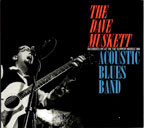 The
Dave Muskett Acoustic Blues Band “Live at the Slippery Noodle,”
features Dave Muskett on guitar, dobro, vocals doing thirteen self-penned
songs, as well as producing, mixing and mastering this 2014 set. He was
assisted by Mark Carnes on harmonica, Jay Arnold on stand up bass and
Charlie Bushor on stripped down drums. The band has a laid back country
blues groove. Carnes’ harp fills behind the guitar and vocals with
the rhythm chugging beneath as Muskett croons and growls some witty lyrics
on tunes like “That Kind Of Walk” and satirical innuendos
on “Handyman Blues” that gives whole new level of meaning
to customer service. Picking up steam halfway through his dobro takes
off on “Rain Song” and “Sweet Mary Jane” while
Carnes shines on “Semi Naked Shoe Shine” with Dave’s
picking taking on a jazzier bend. The rhythm section shows off on the
sing along “Pet That Thing” and everyone is swinging by the
finale “You Got To Know.”
The
Dave Muskett Acoustic Blues Band “Live at the Slippery Noodle,”
features Dave Muskett on guitar, dobro, vocals doing thirteen self-penned
songs, as well as producing, mixing and mastering this 2014 set. He was
assisted by Mark Carnes on harmonica, Jay Arnold on stand up bass and
Charlie Bushor on stripped down drums. The band has a laid back country
blues groove. Carnes’ harp fills behind the guitar and vocals with
the rhythm chugging beneath as Muskett croons and growls some witty lyrics
on tunes like “That Kind Of Walk” and satirical innuendos
on “Handyman Blues” that gives whole new level of meaning
to customer service. Picking up steam halfway through his dobro takes
off on “Rain Song” and “Sweet Mary Jane” while
Carnes shines on “Semi Naked Shoe Shine” with Dave’s
picking taking on a jazzier bend. The rhythm section shows off on the
sing along “Pet That Thing” and everyone is swinging by the
finale “You Got To Know.”
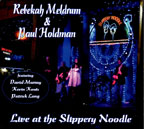 Rebekah
Meldrum & Paul Holdman “Live at the Slippery Noodle” give
a more updated electric sound with Paul Holdman on guitar and vocals,
Dave Murray bass, Kevin Kouts drums, Patrick Long harmonica and featuring
the striking vocals of Rebekah Meldrum on a set of mostly cool covers.
A standout is a dynamic retelling of James Brown’s “It’s
A Man’s World” then shifting straight to Fred McDowell’s
“You Got To Move” with Holdman taking the lead vocals. Rebekah
returns with a gentle version of the Miracles’ “Tracks Of
My Tears” and a forceful “House of The Rising Sun” while
her take on “Georgia On My Mind” lets Holdman’s jazzy
guitar shine. Elmore James’ “The Sky Is Crying” is given
a T-Bone Walker-like treatment from Holdman as Rebekah croons and moans
then takes a down home version of Aretha’s “Baby I Love You”
as Holdman slides into an Elmore-like “Baby Please Don’t Go.”
This self-produced set of fourteen songs is a blend of blues, country
and jazz with a big sound for a small group live.
Rebekah
Meldrum & Paul Holdman “Live at the Slippery Noodle” give
a more updated electric sound with Paul Holdman on guitar and vocals,
Dave Murray bass, Kevin Kouts drums, Patrick Long harmonica and featuring
the striking vocals of Rebekah Meldrum on a set of mostly cool covers.
A standout is a dynamic retelling of James Brown’s “It’s
A Man’s World” then shifting straight to Fred McDowell’s
“You Got To Move” with Holdman taking the lead vocals. Rebekah
returns with a gentle version of the Miracles’ “Tracks Of
My Tears” and a forceful “House of The Rising Sun” while
her take on “Georgia On My Mind” lets Holdman’s jazzy
guitar shine. Elmore James’ “The Sky Is Crying” is given
a T-Bone Walker-like treatment from Holdman as Rebekah croons and moans
then takes a down home version of Aretha’s “Baby I Love You”
as Holdman slides into an Elmore-like “Baby Please Don’t Go.”
This self-produced set of fourteen songs is a blend of blues, country
and jazz with a big sound for a small group live.
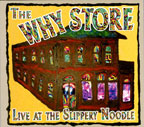 Another
Noodle regular, The Why Store “Live at the Slippery Noodle”
is a more rock-oriented band featuring Christopher Shaffer vocals and
acoustic guitar, Troy Seele electric guitar, Dan Hunt bass and John Gray
drums. The distinctive vocals of Christopher Shaffer floats from a whisper
to guttural growl and powers this band through sixteen songs all written
by Shaffer. Troy Seele’s electric guitar blending with Shaffer’s
acoustic that flow and blend together, complementing each other throughout.
Some songs have a folksy tilt like “Wronging Me,” “Show
Me The Love” and “Halo” but Troy Seele’s guitar
rocks hard through “Never Wanted” and “Broken Glass.”
“Mamas And Papas” hits a strong groove between Shaffer and
Seele that takes a Stooges turn on “I Got It” and finishes
with a flamenco flourish on “Surround Me.” The Why Store is
a rock band with it’s own distinctive sound and it’s understandable
why they’re so popular with their Whomhead followers.
Another
Noodle regular, The Why Store “Live at the Slippery Noodle”
is a more rock-oriented band featuring Christopher Shaffer vocals and
acoustic guitar, Troy Seele electric guitar, Dan Hunt bass and John Gray
drums. The distinctive vocals of Christopher Shaffer floats from a whisper
to guttural growl and powers this band through sixteen songs all written
by Shaffer. Troy Seele’s electric guitar blending with Shaffer’s
acoustic that flow and blend together, complementing each other throughout.
Some songs have a folksy tilt like “Wronging Me,” “Show
Me The Love” and “Halo” but Troy Seele’s guitar
rocks hard through “Never Wanted” and “Broken Glass.”
“Mamas And Papas” hits a strong groove between Shaffer and
Seele that takes a Stooges turn on “I Got It” and finishes
with a flamenco flourish on “Surround Me.” The Why Store is
a rock band with it’s own distinctive sound and it’s understandable
why they’re so popular with their Whomhead followers.
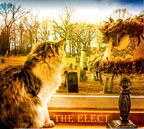 The
studio recording released by Slippery Noodle is a rock Americana band,
The Elect, with a CD titled “Greetings” featuring Michael
Weir vocals, guitar, piano, Brain Miller keyboards, Peter Lenges guitar,
Sam Taylor bass, Chad Baker drums and Jimmy Tucker percussion. All ten
songs are written by Michael Weir and recorded at Primary Sound Studio,
a hundred-year old former church. The Elect’s sound has a rich familiar
quality reminiscent of Van Morrison, Bob Seger, John Fogerty or the Grateful
Dead and their overall tone is a mellow groove.
The
studio recording released by Slippery Noodle is a rock Americana band,
The Elect, with a CD titled “Greetings” featuring Michael
Weir vocals, guitar, piano, Brain Miller keyboards, Peter Lenges guitar,
Sam Taylor bass, Chad Baker drums and Jimmy Tucker percussion. All ten
songs are written by Michael Weir and recorded at Primary Sound Studio,
a hundred-year old former church. The Elect’s sound has a rich familiar
quality reminiscent of Van Morrison, Bob Seger, John Fogerty or the Grateful
Dead and their overall tone is a mellow groove.
If you find yourself in Indianapolis, Indiana, you’re sure to find
some great entertainment any night of the week at the Slippery Noodle
Inn. Until then take a sample of Slippery Noodle Sound home with you.
Meanwhile, the Yeagy’s are recording “Live at the Slippery
Noodle Volume 4” right now!
www.slipperynoodle.com/sound
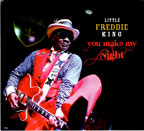 Little
Freddie King
Little
Freddie King
You Make My Night
Made Wright Records
www.littlefreddieking.com
Fread E. Martin is the son of a blues man. He ran away to New Orleans
at 14 and along the way was reborn as his alter ego, Little Freddie King.
Little Freddie’s music can seem deceptively simple with its hypnotic
repetition, churning rhythms and bursts of guitar wrapped around his creaking
vocals. Most of his band has been with him for decades: anchoring the
bottom is ‘Wacko’ Wade Wright, drummer, manager, producer
and probably Freddie’s best friend in the world; harpist and melodic
foil Bobby Lewis Ditullio has been with the band since 2000 and newest
player William Jordan on bass. There ain’t nothing else like Freddie,
always dressed in a sharp suit, hat and shoes, this seventy-six-year old
gentleman can still hang a leg over the neck of his guitar during a solo.
Capturing that spark “You Make My Night” is recorded live
on Freddie home turf, the d.b.a. Music Club on Frenchmen Street in New
Orleans, doing what he does best: raw gut bucket blues.
The set begins with some clean noodling guitar with harp chiming through
the notes and the drum builds to a slow freight train pace driving John
Lee Hooker’s “Hobo Blues” as the guitar moves to a precise
bluesy slop and Freddie’s mournful voice breaks through. Shifting
to his own songs “Can’t Do Nothin’ Baby” chronicle
his travels down Highway 2 past his baby’s door and “Tough
Frog To Swallow” takes you on a tour of what may be some of his
most notorious dives in New Orleans, the repetitious harp drives the song
while “Chicken Dance” both from his 2010 “Gotta Walk
With Da King” has Freddie as the cock of the show crowing out his
glee to the crowd’s delight as the harp is pecking and scratching.
Freddie gives a minute long intro into “Bus Station Blues,”
Freddie’s solo shows what a fine guitar picker he is. Filling out
the set with a number of covers they launch into “Big Boss Man”
with Freddie’s guitar and Wacko’s steady rhythm, the harp
fills between lyrics and takes the solo while in “Baby, Please Don’t
Go” the harp rings out the melody as the guitar answers. “Wang
Dang Doodle” has guitar ringing out the theme with flourishes in
between as Freddie growls out the notorious cast of characters picking
up steam as they near their conclusion. The original instrumental “Sing
Sang Sung” ties up the show, Freddie’s guitar rings out the
lines reminding you of a joyous version of “Killing Floor.”
Little Freddie King is the last of the real old school juke joint bluesman
and his live “You Make My Night” is all the proof you need.—Roger
& Margaret White
 Dave
Fields
Dave
Fields
Unleashed
FMI Records www.davefields.com
Dave Fields has music in his blood. The son of award-winning composer/producer/musician
Sammy Fields, he attended the Berklee College of Music and made a name
on the commercial music scene in NYC. But the blues came calling and his
debut CD “Back in Bluesville” won Best Self-Produced CD at
the 2006 IBC. Dave’s newest CD is “Unleashed,” a fitting
title as half the CD was recorded at his live shows to reveal the real
power of Dave Fields.
Limbering up live at Al Weber’s Studio with “Anticipating
You,” an energetic fusion instrumental featuring Kenny Seoul on
drums, Eric Boyd’s bass, Vladmir Barsky playing keyboards and Doug
Hinrich’s percussion - the energy just leaps off the track then
the band turns to a breakneck country flavored “L.E.S. Hoedown”
and Dave sounds like at least two guitar players. Traveling to the Stanhope
House in New Jersey, Dave is captured with Andy Huenerberg on bass and
Sam Bryant on drums, blasting into “Going Down” in a version
decidedly different then Freddie King or Jeff Beck, the energy splintering
from the speakers. Then taking “Better Be Good” from his “Detonation”
CD, increasing the pace to a power walk as Dave announces to the crowd,
“I just wanna play my guitar…. and have some fun!” Shifting
his base to The Robin’s Nest which he calls “the NY area’s
one and only juke joint,” swapping Dave Moore on drums Fields settles
into a restrained take on “Pocket Full Of Dust” again from
his “Detonation” CD, a Leslie-toned guitar replacing the organ.
Then dipping into Hendrix mode Dave covers “Hey Joe” with
a startling urgency and power going directly into “The Star Spangled
Banner” and reprise of “Hey Joe.”
His studio work takes a more measured approach. His “Child Of The
World” was written after events in Paris with Kenny Soule on drums,
Buddy Allen bass and Vladimir Barsky on organ following with the one true
blues number, “My Mama’s Got The Blues,” JT Lauritsen
adds harp but Dave cuts through those high notes and digs in with “The
Boy Wants To Play.” The “Jagged Line Pt 1” slashes with
a proto metal edge with Van Romaine, drums, Chris Tristram, bass, Vladimir
Barsky, organ, then steps up the tension, power and virtuosity with “Jagged
Line Pt 2.” Powering down to finger snaps, delicate guitar and light
organ, Dave sings affectionately of his home “New York City Nights”
as sweeping strings fill out his land of dreams.
On his newest CD Dave Fields has let his creative urges loose ranging
from blues to fusion and metal, he’s truly been “Unleashed.”
—Roger & Margaret White
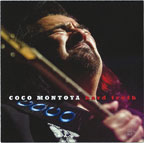 Coco
Montoya
Coco
Montoya
Hard Truth
Alligator 2017
Motion and emotion.
Initially a drummer, and then guitarist with blues greats Albert Collins
and John Mayall, Coco Montoya has fronted his own band for over two decades
and garnered fame and a myriad of Blues Music Award nominations. For his
first album in three years, guitar maven Montoya has recruited an all-star
cast of Southern California musicians and produced nearly an hour-long
set of compelling tunes. Produced by Phantom Blues Band drummer Tony Braunagel,
the set sports fellow Phantom members Mike Finnigan on keyboards and Johnny
Lee Schell on guitar, session luminary Bob Glaub on bass, and guitarist
Billy Watts of Teresa James and the Rhythm Tramps. James herself, with
chanteuse Deb Ryder, provides tasty vocal backing.
With that kind of ensemble, good things happen. The album blasts off with
three uptempo numbers, including covers by Warren Haynes and Ronnie Earl.
Montoya’s piercing single note forays interplay with Finnigan’s
swirling organ fills, particularly on “Lost in the Bottle.”
The group slows the pace on “Old Habits Are Hard to Break,”
a John Hiatt tune introduced by Coco’s evocative solo. Several of
the tracks that ensue are distinguished by the creative second guitars
of Schell and Watts, particularly Johnny Lee’s contribution on “The
Moon Is Full,” delivered while Montoya pays six-string tribute to
mentor Albert Collins.
Motion and emotion. The bulk of the set is blues rock, riding a danceable
beat propelled by the ace rhythm section; that’s the motion. The
emotion emerges on the slower numbers, highlighted by the penultimate
“Where Can a Man Go from Here?” Montoya’s guitar fashionings
shine throughout, but really dazzle on these more languorous tracks.
After listening several times to the CD, my admiration for Montoya melds
with my memories of his fellow bluesman, the late Michael Burks. Like
Burks, Coco can deliver passionate vocals and awesome guitar work, but
just kills it with the occasional slow blues number that exceeds the reach
of many contemporary blues guitarslingers enamored of speed and impetus.
—Steve Daniels
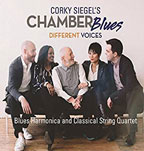 Corky
Siegel’s Chamber Blues
Corky
Siegel’s Chamber Blues
Different Voices
Dawnserly Records
This ongoing project of harmonica legend Corky Siegel features a string
quartet of Jaime Gorgojo (violin), Chihsuan Yang (violin, ehru, a two-stringed
Chinese violin, and vocal). Dave Mass (viola), and Jocelyn Butler Shoulders
(cello). Additionally, tabla player Sandeep Das is on one track, saxophonist
Ernie Watts on one track, vocalists Matthew Santos and Marcy Levy, drummer
Sam Lay and the Chicago-based folk trio Sons of the Never Wrong are also
contributors. Percussionist/drummer Frankie Robinson, a 26-year veteran
of working with Chamber Blues, as well as a decade with Ramsey Lewis,
is prominently featured, as well. Most of the dozen compositions are from
Siegel and, as mentioned, they combine harmonica with string quartet.
To call this brilliant is to state the obvious. It is also demanding music.
It breaks any preconceptions that listeners may have regarding the wedding
of classical string quartet and blues harmonica. The Siegel-Schwall Blues
Band first tackled this alliance of styles in 1973 on a recording with
the Chicago Symphony under the baton of Seji Ozawa. Mr. Siegel saw Alligator
release two Chamber Blues recordings in 1994 and 2005 and in 1998 released
Complementary Colors on Gadfly Records.
The disc at hand opens with a harmonica wail surrounded by the strings
plucking and bowing thoughtfully. Ernie Watts, a first class jazz master
adds his voice to the mix, dueting with and chasing Siegel as the strings
become more cohesive and couching. Missing Persons Blues, Op. 26 sees
these disparate voices join in a harmonious and complementary singular
song, sometimes sounding like an outside jazz piece. On One, also from
his pen, a beautiful harmonica section surrounded by sweet strings sets
the stage for Santos to sing in a jazzy style, “in Paradise a pair
of hearts are one.” Strings, percussion and harp work superbly.
His Time Will Tell Overture, with Das on tabla, is another voice that
weaves seamlessly with strings. The interplay between the strings and
the principals is equally mesmerizing. Just when you get into the classical
mode, along comes Marcy Levy to sing Lay Down Sally, a song she co-wrote
with Eric Clapton. The reading is adventurous with the strings taking
on a percussive and swinging role. This is followed by a captivating string-driven
version of the Siegel-Schwall classic Angel Food Cake. Corky and the strings
work superbly together. On Shadows in a Shoebox, written by Santos, Siegel’s
harmonica introduces the theme, with the strings again gently holding
him before Santos joins in, sometimes scatting the melody. The following
gospel classic, I’ll Fly Away, features the Sons of the Never Wrong’s
Deb Lader, Sue Demel and Bruce Roper on vocals. Demel’s guitar and
Lader’s mandolin are integrated with the string quartet in a marvelous
singing in tandem with percussion and harmonica. Next up is a combination
of Corky’s Italian Shuffle with the blues classic Flip, Flop and
Fly, sung by Sam Lay in a thoroughly enjoyable lope. Keeping contrasts
at the heart of the disc, Galloping Horses, composed by Hai Huang-Hai
features Chihsuan on the ehru. This is followed by the two part Counter
Intuitive, Op.24 from Siegel. This is a swinging harp piece with strings
offering counterpoint. On the second part the viola of Dave Moss is featured.
The closing Siegel composition The Sky Will Fall reminds of Charlie Haden
in its introductory section for its voicing. Siegel sings, “If we
never learn to give/we’ll be facing emptiness…if we don’t
learn to love, the sky will fall.”
Siegel has performed around the world as a guest artist of some of the
world’s greatest symphony orchestras and he has received countless
classical music awards. But, don’t forget that he was the harper
for the great Siegel-Schwall Band. The combination of the two Corkys is
a delight. —Mark E. Gallo
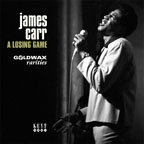 James
Carr
James
Carr
A Losing Game
Kent 45 RPM EP
Ill-fated Southern soul hero James Carr was born to a Baptist preacher’s
family in Como, Mississippi in 1942 and began his career sounding like
Otis Redding before developing a style similar to Percy Sledge and was,
among those in the know, considered better than either of them. After
a brief spell with various Memphis-area gospel groups (including the Harmony
Echoes) he went secular, signing with Quinton Claunch’s local indy
Goldwax Records (after being rejected by Stax) and proceeded to release
a lengthy string of downbeat, wailing, intensely candid hit singles alongside
a few more uptempo flip-sides like the deep soul-ish “That’s
What I Want To Know.” The crossover hits began with 1966’s
pleading “You Got My Mind Messed Up” and continued through
“Love Attack”*, “Pouring Water On A Drowning Man”*,
“The Dark End Of The Street,” “Life Turned Her That
Way, “A Man Needs A Woman,” “That’s What I Want
To Know,” and “Freedom Train” along with a host of others
that were just as deserving of chart action. In addition to the asterisked
pair above, the other two songs on this Limited Edition EP, a great cover
of Marvin Preyer’s “What Can I Call My Own” and Carr’s
original “A Losing Game,” are similarly stunning. Don’t
wait too long—an earlier Carr Kent EP is sold out.—Gary von
Tersch
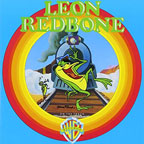
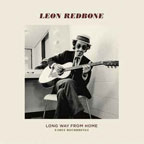 Leon
Redbone
Leon
Redbone
On The Track
Third Man Records—Vinyl LP
Leon Redbone
Long Way From Home: Early Recordings
Third Man Records—Vinyl 2-LP
The recently retired singer/songwriter and deft guitarist, Leon Redbone,
who specializes in jazz, country and Delta blues, ragtime and Tin Pan
Alley classics, is a one-of-a-kind musical wonder in a Baby Gramps, Jelly
Roll Morton, Jesse Fuller or Fats Waller sort of amalgamation. Attired
in his Panama hat and dark sunglasses, he began performing on stage in
Toronto, Canada in the early 1970s with his novel mix of vaudeville routines,
early jazz covers, sly originals and skillfully atmospheric instrumentals.
I once heard his live stagecraft described as “so authentic you
can even hear the surface noise of an old 78 RPM record.” His debut
disc, released on Warner Bros in 1975, features vintage jazzers like Joe
Venuti, Milt Hinton and Joe Wilder along with Charles Macey on Hawaiian
guitar and Don McLean on banjo transfixing and bewildering the earlobes
with numbers on the order of “Ain’t Misbehavin’,”
“Lulu’s Back In Town” and the opening “Sweet Mama
Hurry Home Or I’ll Be Gone.” Long Way Home, on the other hand
proffers a compilation of early recordings from 1972/73 in Buffalo, New
York, split evenly between a coffeehouse gig and radio station WBFO. Throughout
the 18 titles, his scintillating charisma is obvious as he leans heavily
on the songbooks of both Robert Johnson (“If I Had Possession Over
Judgement Day,” and “Kind Hearted Woman Blues” are picks)
and the yodeling cowboy, Jimmy Rodgers (likewise “T.B. Blues,”
“Mother, Queen Of My Heart” and “Gambling Bar Room Blues”)
with room, here and there, for the likes of Blind Blake’s “Bootleg
Rum Dum Blues” and a couple by Irving Berlin. Very recommended.—Gary
von Tersch
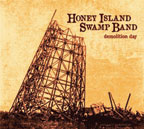 Honey
Island Swamp Band
Honey
Island Swamp Band
Demolition Day
Ruf
This Luther Dickinson-produced gem is one of the standout CDs of the past
year. Toss Little Feat, country Stones, Allman Brothers, and every classic
funky New Orleans groove (from Snooks Eaglin to Dr. John) you’ve
ever heard into a musical blender. What you get is one of the most exciting
bands in the land. This is their fourth album, but my first exposure to
them. The opening How Do You Feel has an opening guitar riff that recalls
the Stones’ Happy, signaling that this is gonna be a fun ride. The
band is comprised of mandolin/ guitar/harmonica player Aaron Wilkinson,
lead guitarist Chris Mule (pronounced Mule-ay), bassist Sam Price, drummer
Garland Paul and keyboardist Trevor Brooks. They trace their journey from
New Orleans, where most of them knew each other, to San Francisco, where
they formed the band following chance meetings after they had all fled
Katrina, and back to New Orleans. They bring their individual and collective
experiences to the gumbo of styles and influences that permeate this superb
recording. On Head High Water Blues they sing of Katrina’s effect
on them and their city. “Get yourself a hammer and saw/it’s
demolition day…Nothing left to fight for/Nothing left to lose/No
one left to cry for/nothing left to prove.” Beautiful slinky guitar
and keyboard interplay. No Easy Way Out has an Allman Brothers feel with
the added allure of brass. “Lipstick on a cigarette still smoking
in the tray/two words on a matchbook say all there is to say/black birds
at the window/circle round and round.” Throughout the recording
it is apparent that this is a meticulous band that sees the lyric/story
as an equal partner to the brilliant playing. On Medicated (“all
of the time”) they remind of NRBQ for the joy and chops that they
bring to the song. Watch and Chain’s lower register electric piano
combines seamlessly with horns on a deep voodoo groove. “My baby
loves me like a watch and chain/she winds me up and runs me down again.”
Slowing it to an acoustic ballad, Katie is an ode to a woman of which
they sing, “Met my Katie on Bourbon Street/She’s so pretty/knocked
me off my feet/Disappeared without a trace/Since I ain’t had a smile
on my face”) and Ain’t No Fun has that Allman inspired slide
and smooth vocal harmonies. They sing, “Maybe someday I can be your
back door man/I’m doing everything I can to be your back door man…It’s
a drag/you know it’s just a drag/that you can put that cat back
in the bag… It ain’t cool/the way you school me/I feel just
like a fool…” The distinct instrumentation is clear and clean.
She Goes Crazy with an intro reminiscent of Harry Nilsson’s Coconut
melds into “I can’t sit still/my vision’s bent/I ain’t
seen my baby since I don’t know when/she’s got pretty hair
and a great big smile/don’t mess with her cause you know she’s
wild/that’s my girl/that’s my baby/she goes crazy.”
Through Another Day, following a harp intro, makes way for a dominating
mandolin intertwining with exquisite slide filigrees. On Say It Isn’t
True Wilkinson sings, “I used to be a good man/on a winning track/now
I walk a lonely road/counting tears and looking back/what have I done?/I
threw it all away.” The music is as moody and wistful as the lyrics,
making for a powerful and emotive ballad. On the closer, Devil’s
Den, the groove is spooky midnight and the battle with demons seems imminent.
“Lord knows I tried and tried/but I’m down upon my knees/have
pity on my evil soul.” The instrumentation is largely acoustic and
cinematic. Like the rest of the album, it is easy enough to pick it apart
to name influences, but suffice it to say that this is a brilliant album.
—Mark E. Gallo
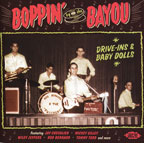 Bopping
Bopping
By The Bayou
Drive-Ins & Baby Dolls
Various Artists
Ace CDCHD-1486
As it cloud-burstingly proclaims in Ian Saddler’s image-laden liners
introduction: “This sixth volume in the “Bopping By The Bayou”
series, the 16th in the overall “Bayou” series, is a mix of
previously unissued recordings, rare 45s, tracks pulled from old compilations
and the odd goodie reissued legally for the first time.” Indeed,
what we have here is a superb collection of hot rockers, cool boppers
and Cajun thumpers compiled for the explicit enjoyment of lovers of Louisiana
and South Texas music. And all 28 titles, from Cookie Roberts’ opening
“Draggin’ At The Drive-In” to Jay Chevalier’s
topical closer “Kruschev And The Devil,” have a decided rockabilly/early
rock ‘n’ roll heart—these are musicians, known and unknown,
who were all hoping to be the next Elvis Presley, Jimmy Reed, Johnny Cash,
Screamin’ Jay Hawkins, Duane Eddy, Chuck Berry or Clifton Chenier.
Ah, that pre-Bobby Rydell era! Favorites in my household begin with Terry
Clements & The Tune Tones and their rave-up “Rock Me Mama”
and continue through Rod Bernard’s inspired recall of Mr. Berry’s
classic “No Money Down,” Pee Wee Trahan’s rockabilly-styled
version of the c&w standard “Prisoner’s Song,” Wiley
Jeffers’ wild-ass recall of Mr. Presley’s Sun hit “Baby
I Don’t Care” and a pre-urban cowboy” Mickey Gilley
(who at 80 is still performing) with a rockabilly resplendent “Drive
In Movie.” Also noted: Johnny Winter plays lead guitar on Burl Boykins’
boisterous original “Let Me Come Your Way.” Saddler notes
that Boykin was known as “Little Elvis” for his no-holds-barred
version of “Hound Dog.” Bonzer! - Gary von Tersch
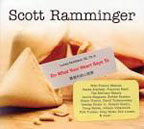 Scott
Ramminger
Scott
Ramminger
Do What Your Heart Says To
Arbor Lane Music
Scott Ramminger is a saxophonist and vocalist who brings a wheelbarrow
full of chops and talent to this groove-laden project that features both
a killer band and an impressive list of guest artists. Recorded in New
Orleans, it’s all about N’awlins through and through. The
opening Living Too Fast features the Subdudes’ Tommy Malone duetting
with Ramminger, who sings, “We talked about our lives for hours/I
knew this one was gonna last/She come to the conclusion/ that I was livin’
too fast/she poured my bottle out in the ocean/She threw my cigarettes
in the trash/She sold my motorcycle/gave a buddy of mine my stash/She
come to the conclusion/that I was livin’ too fast.” A medium
tempo lope it’s highly infectious. He’s a clever songwriter,
a superb saxophonist and a fantastic vocalist. Pianist David Torkanowsy
and bassist George Porter, Jr. keep the groove percolating with guitarist
Shane Theriot, drummer extraordinaire Doug Belote, and a horn section
of trombonists Rick Trolsen and Greg Hicks and trumpeter Eric Lucano.
On the following Someone to Disappoint, vocalist Bekka Bramlett joins
Ramminger on the roadhouse rockin’ tune on which Ramminger reminds
of Delbert McClinton. She returns for the ballad of Hoping That The Sun
Don’t Shine (“the eggs that I just fixed/taste like cardboard
in my mouth/I’ve hardly slept at all/since the day that you walked
out”) on which his tenor is a delight.
Then comes the great Francine Reed to share the vocals with Ramminger
on the title cut. “You gotta shake things up/do what your heart
says to.” They sing, “She’s so low/your brain is telling
you that/she’s gonna spend your money/ and drop you flat/you’ll
get beat up bad/then she’ll hand you your hat” over a rhythmic
pattern set up on drums and piano. Superior songwriting. The McCrary Sisters,
among the shining stars of gospel music, are here with Ramminger on four
tunes, of which the ultra-funky Give a Pencil to a Fish and Get Back Up
are most impressive. Again, that lush tenor rules. Janiva Magness adds
her vocals to the humorous It’s Hard to Be Me (“I make up
these stories/to hang on to your love/I give and I give girl/but it’s
never enough/it takes a lot of hard work/to come up with this stuff”).
The closing Stubborn Man, with Roddie Romero on accordion, has a decided
zydeco feel, showcasing Ramminger’s diversity.
One of the highlights of this new year, Do What Your Heart Says is a funky
blues affair that sounds better with each listen. This is highly recommended.
—Mark E. Gallo
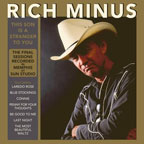 Rich
Minus
Rich
Minus
This Son Is A Stranger To You
Saustex CD
This seven track CD is a posthumous release by well-kept-secret Texas
singer/songwriter Rich Minus, whose gritty, saucily playful songwriting
style often recalled the likes of Townes Van Zandt, Steven Fromholtz or
Guy Clark. Recorded at the legendary Sun Studio in Memphis and produced
by Grammy Award winner Matt Ross-Spang, it stands alongside a trio of
great full-length albums he recorded in the early 1990s for France’s
New Rose imprint. The colorful, hard-drinking Minus is perhaps best known
for his “Laredo Rose” composition that opens affairs and which
Doug Sahm and his all-star Texas Tornados had some luck with (Minus also
used to open for them) but there’s nary a clunker in the bunch here—the
cream of the crop, so to speak—from the wryly philosophical “Penny
For Your Thoughts” and “The Most Beautiful Waltz” through
the arresting “Last Night” and “Blue Stockings”
to a portrait of “Connie” and the imploring “Be Good
To Me.” The hand-picked backing band includes Neil Young drummer
Steve Potts, Johnny Cash’s bassist Dave Roe and Ryan Adams’
firebrand guitarist. Well worth the search!—Gary von Tersch
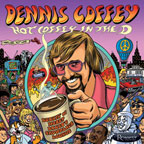 Dennis
Coffey
Dennis
Coffey
Hot Coffey In
The D (Burnin’
At Morey Baker’s Showplace Lounge)
Resonance Records
www.denniscoffeysite.com
Dennis Coffey is a legendary guitarist who in the ‘60s played on
untold Motown hits by day and by night in the clubs led an experimental
movement to fuse jazz, soul, rock and R&B creating a groove that led
to the foundations of funk. But where did this sound come from? This “lost”
recording, now titled “Hot Coffey In The D” captured that
spark in its infancy as it burst forth. Coffey came up on the cusp of
early rock ’n roll a session musician, Lyman Woodard, a young Hammond
B-3 prodigy schooled at Oscar Peterson’s Advanced School Of Contemporary
Music, Melvin Davis a songwriter, soul singer, drummer for the Miracles.
They became a local powerhouse trio in an emerging scene, providing backing
as a studio band and drawing crowds to listen at their live shows.
Taped at a regular gig in 1968 at Morey Baker’s Showplace Lounge
in Detroit you can hear the sparks smoldering on their original opener
“Fuzz,” the restrained organ and steady rhythm building as
an effects-heavy guitar slowly asserts its dominance cutting with its
rhythmic chops and slashing riffs. Slowing the pace for “By The
Time I Get To Phoenix” and “The Look Of Love” with gentle
guitar statements of the themes the band expands with improvisational
energy, the drumming is solid while constantly shifting as the mood of
the organ churns and holds the bottom on the bass pedals before restating
the themes turning these popular tunes of the day into a funky grooves.
Herbie Hancock’s “Maiden Voyage” sticks to its jazz
roots while their funky original “The Big D” is a full blown
forerunner of the Coffey sound today while giving Woodard free rein on
organ. The little known soul number “Casanova” (Your Playing
Days Are Over) originally recorded in ‘67 on the Zodiac label is
done as a seven minute instrumental jam that won’t disappoint. The
shimmer of the keys flows fluidly for Ramsey Lewis’ version of “Wade
In The Water” till Davis and Coffey step in and take it to deeper
depths.
This unearthed time capsule is nearly fifty-years old yet still sounds
fresh and stimulating. These improvisational tracks are a prelude to the
sound Dennis Coffey is still doing in his weekly show at the Northern
Lights in Detroit today. If you can’t make it down to the club put
on some “Hot Coffey In The D,” enjoy this tasty brew and hear
where it all began. —Roger & Margaret White
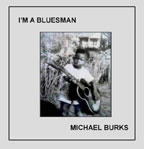 Michael
Burks
Michael
Burks
I’m a Bluesman
Iron Man Records
They called Michael Burks the Iron Man. He was as good an electric blues
guitarist and singer as you’ll ever hear. These recordings from
1998 are seeing the light of day for the first time. Burks died of a heart
attack in 2012 at age 54. Bob Greenlee, who originally recorded these
tracks for his King Snake label, has passed, as has the rhythm guitarists
on the set, Ace Moreland and Warren King. That these recordings were released
takes on that more of an importance. Wightman Harris brought these out
of the shadows for which I will be eternally grateful.
Burks’ recorded output was relatively scant. He recorded his debut
album in 1997 (From the Inside Out for Vent Records) before Alligator
picked him up and released four outstanding recordings with Make It Rain
(2001), I Smell Smoke (2003) and Iron Man (2008). In 2013 they released
Show of Strength posthumously. Each was a revelation. As is the release
at hand.
The set opener, What Are You Doin’ to Me has a bit of draggin’
Godzilla through the alley to it. Lyrically, it tells the tale of walking
in on his lady and someone else. The scorching guitar tells the tale as
convincingly as his vocals. Conspicuously Albert King inspired, he had
that smooth power that few outside of King possessed. The sparks fly off
his guitar, the band rocks solid and the horns are on fire. Check out
I Didn’t Take Your Woman (“you gave her to me”) for
an exercise in electric virtuosity. The surprise cut on the disc is the
absolutely stunning version of the Hall & Oates hit, Sarah Smile.
Blues artists tackling pop tunes is usually a bad idea. Iron Man’s
version is an improvement over an already stellar version by Hall &
Oates. The guitar work is jaw-dropping and emotive.
My Little Girl has an Otis Redding quality. Crisp horns and a medium tempo
that tantalizes. As is the case throughout, his inventiveness on the guitar
is a treat. He was able to tell a tale with no words. When he sings “I’m
a Bluesman until I die…like peanut butter and jelly” you know
he’s totally from the heart. This disc just did not want to come
out of the player. Gets my vote for the most significant historical release
of the past year. Highly, (did I say Highly?) recommended. Great album!
—Mark E. Gallo
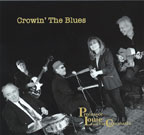 Professor
Louie and The Crowmatix
Professor
Louie and The Crowmatix
Crowin’ the Blues
Woodstock Records 2016
The name of the band may suggest an academic ornithologist investigating
the esoteric behavior of a particular species of bird. No, actually, it’s
the blues.
Based in Woodstock, NY, this quintet, led by Louie on keyboard and vocals,
was long associated with The Band, erstwhile fellow Woodstock denizens.
Louie fronts a rhythm section comprised of Gary Burke on drums and Frank
Campbell on bass, with Miss Marie lending vocal and percussion support
and John Platania handling the guitar duties.
This follow-up to the group’s praised 2016 Americana release, “Music
from Hurley Mountain,” shifts back to blues roots. Featured are
covers of such classics as B.B. King’s “Confessin’ the
Blues” and Elmore James’ “Fine Little Mama.” All
are considerably altered from the original versions of their progenitors.
Jimmy Reed’s “Bright Lights, Big City,” for example,
trades its Louisiana gumbo drawl for a meandering version driven by the
Professor’s piano. Similarly, the oft-covered “High Heel Sneakers”
is slowed from the uptempo renditions of many previous cover performers.
Jimmy Rogers, Big Bill Broonzy, and Jimmy McCracklin are some of the other
late blues legends whose tunes appear on the album. While lacking the
grit and gleam of the original renditions, the vocals provided by Louie
and Marie fit well with the overall approach. Especially noteworthy is
the track “Love Is Killing Me,” with multiple tuneful vocal
harmonies, Campbell’s propulsive bass, and extra guitar contributions
from Josh Colow and Michael Falzarano (the latter a frequent participant
in Hot Tuna gigs).
Finally, kudos to Platania, whose name may be familiar from his three
decades playing guitar for Van Morrison. His playing is the highlight
of the album.— Steve Daniels
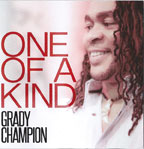 Grady
Champion
Grady
Champion
One of a Kind
Malaco 2016
Mississippi-born and -based bluesman Grady Champion has an eclectic history,
beginning in the music industry as a record promoter, segueing into a
brief career as a rapper, and for the last fifteen years blazing a trail
as a bluesman. Adept at songwriting, singing, and harmonica playing, he
has also cemented his reputation as a dynamic showman.
Thus it’s no surprise that on this, his tenth release, he evokes
comparison with another Mississippi son of the blues with similar talents.
That would be none other than the venerable and widely lauded Bobby Rush.
Like Rush’s best efforts, “One of a Kind” features upbeat
and danceable tunes, soulful lead vocals, spirited backing vocals, and
lyrics both timely and lascivious. Neither Rush nor Champion go in for
double entendre; it’s more like one-and-a-half entendre. “Bump
and Grind,” “Heels and Hips”…you get the idea.
On this set Champion’s guitarist of choice is fellow Mississippian
Eddie Cotton, noted bluesman in his own right, who distinguishes himself
throughout with sizzling leads and tasteful fills. Mr. Sipp (Castro Coleman)
and Theodis Ealey add to the six-string lineup on a couple of tracks each,
and Elvin Bishop lends his slide expertise to one of the standout cuts,
“What a Woman.” (That slow shuffle is worth the price of admission.)
Sam Scott holds down the drum chair, Myron Bennett and Ken Smith alternate
bass duty, and Carroll McLaughlin provides quality keyboard artistry.
The Jackson Horns goose multiple tunes into overdrive.
Adept as Bobby Rush at deploying the Mississippi saxophone, Grady is more
than competent at single note solos but more frequently prefers chording
on the harmonica, which does heavy duty here. Champion’s composer
or co-composer credit on eleven of the dozen songs attests to his songwriting
ability, and his growling vocals again raise memories of Rush. However,
Grady is also capable of smoother soul singing, as exemplified by “Move
Something,” a call to dance. The set ends with the extended instrumental
“GC Boogie,” affording some solo time to each principal and
ending this party platter on a continued celebratory note. —Steve
Daniels
BOOKS
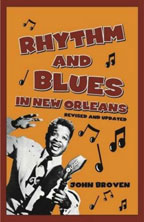 Rhythm
And Blues In New Orleans
Rhythm
And Blues In New Orleans
By John Brown
Pelican Press
Originally titled after Fats Domino’s early “Swamp Pop”
smash Walking To New Orleans upon its initial publication in Great Britain
more than forty years ago, author and music researcher, John Broven, has
expanded affairs mightily for this recent Pelican Press edition with an
abundance of new information and interviews, additional images, recently
uncovered biographical data and a greatly expanded, user-friendly appendix.
All illuminatingly describing that happy-go-lucky musical magic that
created that vaunted New Orleans sound that eventually was heard around
the globe with ambassadors on the order of Mr. Domino, Professor Longhair,
Doctor John, Irma Thomas, Dave Bartholomew, Huey “Piano” Smith,
Frankie Ford, Allen Toussaint, Wardell Quezergue, Harold Battiste and,
above all, studio whiz Cosimo Matassa. Interview segments with the Night
Tripping Doctor, Bartholomew, Toussaint, Battiste and Matassa are particularly
revealing. Perceptive new input is also provided by Jeff Hannusch (“the
effect that Hurricane Katrina has had on the current trends of New Orleans
music is undeniable”), Rick Coleman, Ben Sandmel and Ira “Dr.
Ike” Padnos along with material on the groundwork provided by the
New Orleans Jazz and Heritage Festival, community radio station WWOZ and
Offbeat magazine. In addition to chronicling the careers and music (that
Dr. John described as “strong drums, heavy bass, light piano, heavy
guitar, light horn and strong lead vocal”) of both major and minor
artists, Broven also draws the bead on the independent record business
activities in the Crescent City that began with New Jersey’s De
Luxe Records in 1947 (with Roy Brown’s classic, bawdy shouter “Good
Rockin’ Tonight”) and continued apace with the crossover likes
of Aladdin’s Shirley & Lee, Atlantic’s Ray Charles and
Professor Longhair, Specialty’s Guitar Slim and Little Richard and
Imperial’s Fats Domino and Smiley Lewis, to mention only a few.
In the process, Broven also details the climactic rise and fall of the
local R&B scene that proved very influential in the development of
rock & roll and soul music—from Brown’s early recordings
in the 1940s to the onslaught of the Beatles in the mid-1960s to the area’s
studio missteps in the late 1960s. And the beat goes in. As Broven sagely
puts it on the book’s final page: “Recently, the emergence
of both the Ponderosa Stomp and the French Quarter Festivals serves as
an important platform for local artists—the 2015 headliners were
Irma Thomas and the, sadly, late Allen Toussaint. And if you want to listen
to what you’re reading, Ace Records in London has recently reissued
plenty of it in their ongoing “By The Bayou” series of releases.
My review of the latest album, “Drive-ins & Baby Dolls,”
appears in this issue. Bon ton roulet!—Gary von Tersch
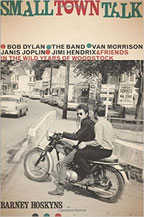 Small
Town Talk
Small
Town Talk
By Barney Hoskyns
Da Capo Press
The small upstate New York “getaway” town of Woodstock, had
begun life as a Catskills bohemian arts colony in 1903 (the fabled three-day
Woodstock Music & Art Fair was actually held on Max Yasgur’s
600 acre dairy farm miles away) but by the early 1960s the woodsy enclave
had attracted a host of musicians from the New York City folk scene and
beyond who had decided to “get it together in the country”
as Londoner and esteemed music historian Barney Hoskyns puts it. It’s
perhaps most famous as the place where Bob Dylan and the Band recorded
the “basement tapes” in a pink house due east of the tiny
town of West Saugerties under the aegis of Dylan’s first manager,
the gourmandizing Albert Grossman, who put together a small fiefdom of
studios and restaurants—even his own record label— in the
area. Along with other habitues like Fred Neil, Tim Hardin, Bobby Charles,
Peter Paul & Mary, Karen Dalton, Paul Butterfield, Happy and Artie
Traum, Geoff and Maria Muldaur and Todd Rundgren as well as “illustrious
visitors” such as Jimi Hendrix, Janis Joplin, George Harrison and
Van Morrison (just to cite a few) everyone is given the “behind
the scenes” up-close-and-personal treatment, dark corners, hard
drugs and all, in Hoskyns’ engrossing oral history of sorts. Drawing
on copious first-hand interviews with the surviving major players on the
scene (Hoskyns also lived there himself in the 1990s), he has come up
with a copiously illustrated East Coast complement to his well received
Los Angeles canyon classic Hotel California of a few years ago. As he
relates in his scene-setting prologue: “From the roots put down
in Woodstock by Dylan and Grossman an extraordinary scene emerged and
gave rise to the notion of Woodstock as a countercultural touchstone—a
hippie state of mind that went so far beyond the town itself that when
Michael Lang had to move his 1969 festival sixty miles away, he did not
for a moment consider dropping the name.” An absorbing, totally
fascinating read.—Gary von Tersch
Home
/ Blues Blogs /
Artist Links / Blues
Links / Videos / Store
Subscribe / Advertise
/ Back Issues
/ Contact / Staff